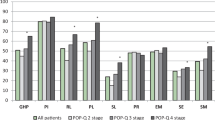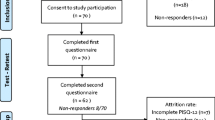Abstract
Introduction and hypothesis
This study aimed to validate the Slovakian version of the prolapse quality-of-life (P-QOL) questionnaire.
Methods
The P-QOL questionnaire was translated into the Slovakian language and administered to women recruited from a urogynecology outpatient clinic at a tertiary referral teaching hospital. After completing a questionnaire, all women were examined in supine position using the Pelvic Organ Prolapse (POP-Q) Quantification system. The reliability was assessed by using a 2-week test–retest analysis.
Results
Fifty symptomatic and 79 asymptomatic women were included. The score of P-QOL was strongly correlated with the vaginal examination findings among the symptomatic group (p < 0.001 in eight domains). P-QOL domain scores were significantly different between symptomatic and asymptomatic women. The test–retest reliability confirmed a highly significant correlation between the total scores for each domain (p < 0.001).
Conclusion
The Slovakian version of the P-QOL questionnaire is a valid, reliable, and easily comprehensible instrument to assess quality of life of women with uterovaginal prolapse.
Similar content being viewed by others
References
Olsen AL, Smith VJ, Bergstrom JO, Colling JC, Clark AL (1997) Epidemiology of surgically managed pelvic organ prolapse and urinary incontinence. Obstet Gynecol 89:501–506
Boyles SH, Weber AM, Myer L (2003) Procedures for pelvic organ prolapse in the United States, 1979–97. Obstet Gynecol 188:108–115
Digesu AG, Khullar V, Cardozo L, Robinson D, Salvatore S (2005) P-QOL: a validation questionnaire to assess the symptoms and quality of life of women with urogenital prolapse. Int Urogynecol J 16:176–181
Digesu GA, Santamato S, Khullar V, Santillo V, Digesu A, Cormio G et al (2003) Validation of an Italian version of the prolapse quality of life questionnaire. Eur J Obstet Gynecol Reprod Biol 106:184–192
de Oliveira MS, Tamanini JT, de Aguiar Cavalcanti G (2009) Validation of the prolapse quality-of-life questionnaire (P-QoL) in Portuguese version in Brazilian women. Int Urogynecol J Pelvic Floor Dysfunct 20:1191–1202. doi:10.1007/s00192-009-0934-6
Lenz F, Stammer H, Brocker K, Rak M, Scherg H, Sohn C (2009) Validation of a German version of the P-QOL Questionnaire. Int Urogynecol J Pelvic Floor Dysfunct 20(6):641–649
Cam C, Sakalli M, Ay P, Aran T, Cam M, Karateke A (2007) Validation of the prolapse quality of life questionnaire (P-QOL) in a Turkish population. Eur J Obstet Gynecol Reprod Biol 135(1):132–135
Bump RC, Mattiasson A, Bo K, Brubaker LP, Jo DeLancey, Klarskov P et al (1996) The standardization of terminology of female pelvic organ prolapse and pelvic floor dysfunction. Am J Obstet Gynecol 175:10–17
Digesu GA, Khullar V, Cardozo L, Robinson D (2008) Inter-observer reliability of digital vaginal examination using a four-grade scale in different patient positions. Int Urogynecol J Pelvic Floor Dysfunct 19:1303–1307
Lukacz ES, Lawrence JM, Buckwalter JG, Burchette RJ, Nager CHV, Luber KM (2005) Epidemiology of prolapse and incontinence questionnaire: validation of a new epidemiologic survey. Int Urogynecol J Pelvic Floor Dysfunct 16:272–284
Srikrishna S, Robinson D, Cardozo L, Gonzalez J (2008) Is there a difference in patient and physician quality of life evaluation in pelvic organ prolapse? Int Urogynecol J Pelvic Floor Dysfunct 19:517–520
Tamanini JTN, Almeida FG, Girotti ME, Riccetto CLZ, Palma PCR, Rios LAS (2008) The Portuguese validation of the International Consultation on Incontinence Questionnaire-Vaginal Symptoms (ICIQ-VS) for Brazilian women with pelvic organ. Int Urogynecol J Pelvic Floor Dysfunct 19:1385–1391
Fayyad A, Hill S, Gurung V, Prashar S, Smith ARB (2007) How accurate is symptomatic and clinical evaluation of prolapse prior to surgical repair? Int Urogynecol J Pelvic Floor Dysfunct 18:1179–1183
Digesu GA, Salvatore S, Chaliha C, Athanasiou S, Milani R, Khullar V (2007) Do overactive bladder symptoms improve after repair of anterior vaginal wall prolapse? Int Urogynecol J Pelvic Floor Dysfunct 18(12):1439–1443
Abrams P, Cardozo L, Fall M, Griffiths D, Rosier P, Ulmsten U et al (2002) Standardisation sub-committee of the international continence society. The standardisation of terminology of lower urinary tract function: report from the standardisation sub-committee of the international continence society. Neurourol Urodyn 21:167–178
Acknowledgements
Our thanks to the Gynecology Outpatient Departments of Krupova Maria MD, Krkoskova Katarina MD, Lackova-Krivusova Denisa MD, Bellan Branislav MD, and Reznakova Slavomira MD for their cooperation.
Funding
None
Conflicts of interest
None
Author information
Authors and Affiliations
Corresponding author
Appendix
Appendix





Rights and permissions
About this article
Cite this article
Svihrova, V., Digesu, G.A., Svihra, J. et al. Validation of the Slovakian version of the P-QOL questionnaire. Int Urogynecol J 21, 53–61 (2010). https://doi.org/10.1007/s00192-009-0989-4
Received:
Accepted:
Published:
Issue Date:
DOI: https://doi.org/10.1007/s00192-009-0989-4




